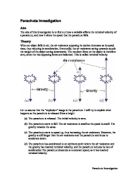The possible variables that can be used are:
- The weight of the parachutist to see if it effects the acceleration.
- The area of the parachute to see if it increases the drag.
- The length of the parachute string to see if it increases/decreases the drag.
- The height of which it is dropped from to see at which height would it hit the ground the fastest at.
Fair Test
To make this experiment a fair test and to control the variables it is considered that:
- It will be dropped in a place which is not windy and made sure that it is redone if it bumps into something because it will affect the results.
- The height of which it is dropped will always be measured 2 meters.
- The same parachute will be used each time.
The changing variable is:
- The weight of the parachutist, so each time 5 grams will be added on to see how it effects the time taken to hit the ground.
Equipment
The equipment needed in this experiment is:
- A plastic garbage bag for the parachute
- String for the connecting rope
- Plastacine for the weight of the parachutist
- A metre ruler to measure the height
- Tape and scissors for construction
- A scale to measure the plasticine
- A timer to record the times
This is a diagram to show the apparatus:
Method
- Collect all equipment needed as said above.
- Cut out the garbage bag 40cm by 36cm and poke 4 small holes in the corners.
- Cut out four 20cm lengths of string.
- Loop and tie one end of each string around each corner.
- Weigh them on a scale and record results.
- Tape all the loose ends together in a knot.
- Measure 4 chunks of plastacine, 5g, 10g, 15g, and 20g.
- Place the taped ends of the string in the first ball.
- With a metre ruler, measure 2m up somewhere easy to hold up.
- One person must drop the parachute and the other times how long it takes to hit the ground (reach terminal velocity). This is done 10 times for an average.
- Record results, and then change to a heavier ball and so on.
The way that I am measuring the free-fall velocity is by timing it from when it is let go and then when it first contacts the ground. Each time, the parachutist gets 5g heavier.
The readings I am going to record are done 10 times to get am average and timed using a stopwatch in seconds/milliseconds, so it is a more accurate answer.
Results Table (also see graph)
Conclusion/Analysis
From the results, I found out that as the weight of the parachutist increases, the velocity increases and speeds up.
Evaluation
I evaluate that the experiment was successful. The recorded results were very accurate because the results were on the line of best fit very closely. Therefore, there were no rogues and this proves that my experiment went well.
However, in an experiment like this there still could be rouges. It can be caused by:
- The wind, blowing the parachute about too much will cause it to sway and therefore the free-fall drop would not be accurate
- The parachute may knock into something and slow down the constant speed
- The timing of height a little out of control by human error
I think that the method I used was accurate enough because I stood at a table top and held a ruler, then dropped it saying ‘go’ and ‘stop’ to the timer every time. The graph proves that it was successful. To improve the accuracy, I could have stood further away from the edge, because several times it bumped a cupboard by accident. Also, the air con should be turned off to prevent the wind.
There were just about enough readings to say it was a firm conclusion, but I think maybe one or two more would be a bit better.
The different variables I could have used to extend my work were:
- To change the area size of the parachute to investigate different drag
- The height of which the parachute would be dropped from
- The length of the string to see how it effects the parachute shape
I think that using these three variables would be useful to find out how the drag, height, and shape would effect the time taken for it to hit the ground. What I would expect to find out for these are:
- Size of parachute – it would take a longer time for the parachute to hit the ground as the size increases because a bigger surface area would mean that more air is trapped beneath the parachute surface holding it up for longer
- Height – with a shorter distance, it would take less time to hit the ground, and with a longer distance, longer time.
- Shape – the longer the strings, the time taken is shorter because of the weight as well as the shape is longer, so then there is less air trapped underneath a oval shaped area.








